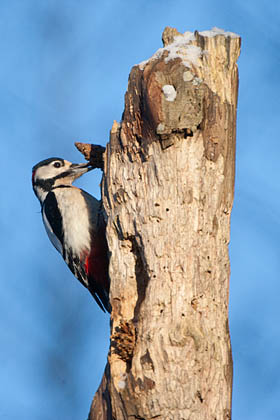Forest life along wintery paths
Photo: Arne Ader
Translation: Cax
Great spotted woodpecker at its forge
Great spotted woodpecker Suur-kirjurähn
Day by day more and more ski tracks appear on the wintery forest floor. Not everyone wants to ski on the paths, ready and lit up, instead they wish to drive in their own prints onto untouched snow of the fringe of the woods. There’s always a possibility to see or at least hear something or someone in the otherwise wintrily quiet woods. Tappings of the woodpeckers are rather muffled, not resounding as they are at springtime: a moment of quiet and a repeat.
A woodpecker is working at the cone in his forge.
The great spotted woodpecker is our most common and often seen woodpecker. They are more numerous in winter, by a couple of hundred thousand birds, than in summer. Feathers on their back are black, with a big white patch on the shoulder. The underparts are white and the chest looks quite dirty. Feathers under his tail are bright red and the sides have white stripes. The great spotted woodpecker has a white spot on its forehead, and the crown of the head, or cap, is black. The male can be recognized by his red patch on the nape, the female’s nape is black. A juvenile’s crown feathers are red and the undertail is pink. The tail is pointed and stiff, acting as a support at working the cones.
For a forge the woodpecker finds a crack in a branch or the trunk of a hardwood or conifer tree, living or dried, and there can be many of them for one bird. The cone will be fixed with the tip up.
A cone, worked over with the strong beak, looks later quite ragged. As mostly seed-eating during winter time, the great spotted woodpecker gets its daily seeds from up to one hundred cones per day, so a quite large “refuse dump" grows under some forges. When you look under the forge, you can see that some cone stumps are chewed completely clean from scales – it shows that wood mice have found that place. They cannot have the seeds, left there by woodpecker, unless they chew the scales off. So there should be footprints of the mice, too...









